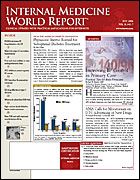Publication
Article
Internal Medicine World Report
ADA Advocates Systematic Exercise Regimen for Type 2 Diabetes
Author(s):
The Evidence Is Overwhelming
Diabetes Care
Focusing primarily on patients with type 2 diabetes and the prevention of this disease, the American Diabetes Association (ADA) recently issued a statement on the benefits of physical activity and exercise in this patient population for reducing morbidity and mortality (. 2006; 29:1433-1438). The following is an overview of some of the key topics covered in this statement.
New England Journal of Medicine
In 2 randomized trials published in the (2001;344:1343-1350, 2002; 346:393-403), lifestyle interventions, including approximately 150 min/week of physical activity and diet-induced weight loss of 5% to 7%, produced a 58% reduction in the risk of progressing from impaired glucose tolerance (IGT) to type 2 diabetes. Data show that programs that include increased physical activity and modest weight loss can reduce the progression of IGT to full-blown type 2 diabetes.
Glycemic Control
JAMA
A systematic review and meta-analysis on the effects of structured exercise activities in clinical trials of ≥8 weeks’ duration on hemoglobin A1c and body mass in patients with type 2 diabetes (. 2001;286:1218-1227) showed that following such an exercise regimen had a clear beneficial effect on glycemic control, which was unrelated to weight loss. This review and subsequent data provide support for patients with type 2 diabetes engaging in moderate-intensity exercise to garner additional glycemic control benefits.
CV, Overall Mortality
Diabetes Care
Ann Intern Med
JAMA
Three large cohort studies reported that increased levels of regular aerobic exercise and/or physical activity were found to lower subsequent cardiovascular (CV) and overall mortality risk more than glucose lowering alone (. 2004;27:83-88; . 2000;132:605-611, 2001;134:96-105). Mechanisms through which exercise could potentially improve CV health include decreased systemic inflammation, improved early diastolic filling, improved endothelial vasodilator function, and decreased abdominal visceral fat accumulation (. 2002;288: 1622-1631).
How Much, How Often?
Sports Med
According to the US Surgeon General’s report, ≥30 minutes of moderate-intensity activity is recommended on most, or all, days of the week for most people. Data have shown that the effect of 1 session of aerobic exercise on insulin sensitivity lasts from 24 to 72 hours, depending on the duration and intensity of the activity (. 1998;25:25-35). As a result, the ADA recommends that patients with type 2 diabetes should not go more than 2 consecutive days without aerobic physical activity.
Lose Weight and Keep It Off
Am J
Clin Nutr
Successful weight-loss programs include a combination of diet, exercise, and behavior modification. Studies have shown that the optimal amount of exercise to attain sustained weight loss is probably much greater than needed to achieve enhanced glycemic control and CV health ( . 1989;49: 1115-1123, 1997;66:551-556, 2002;75: 499-504).
Med Sci Sports Exerc
Sports Med
The American College of Sports Medicine recommends the inclusion of resistance training in fitness programs in adults with type 2 diabetes (. 2000;32:1345-1360). And it has been shown that resistance training improves insulin sensitivity to approximately the same degree as aerobic exercise (. 1997;24:321-336).
No Excuses
The ADA recommends that patients with IGT adhere to a program of weight control that includes at least 150 min/week of moderate-to-vigorous physical activity and a healthy diet with modest energy restriction in an effort to prevent progression to type 2 diabetes.
Unless contraindicated, patients with type 2 diabetes should engage in resistance exercise (eg, weight training, weight machine use) at least 3 times a week, targeting all major muscle groups, with the goal of progressing to 3 sets of 8 to 10 repetitions, at a weight that cannot be lifted more than 8 to 10 times.
Patients who take insulin or secretagogues should check capillary blood glucose before, after, and several hours after an exercise session. Those with a tendency to develop hypoglycemia can reduce their intake of insulin or secretagogues before exercising and/or consume extra carbohydrates during their sessions.
The ADA says that patients with type 2 diabetes should not go more than 2 consecutive days without aerobic physical activity.





